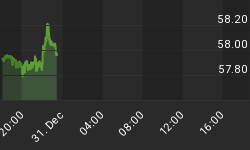I am always amazed at how Wall Street is so easily fooled by statistics. If a number merely exceeds some consensus expectation, markets will react favorably, regardless of the misleading nature of the statistics themselves. It is purely an exercise in form over substance.
The perception that inflation is not a problem so long as "core numbers" remain relatively unaffected will one day be rightfully regarded as one of the poorest collective judgments in an era replete with similar lapses of common sense. For example, as the government released the largest increases in the CPI and PPI in 25 and 15 years respectively, Wall Street reacted favorably to the more benign nature of the irrelevant, yet widely-followed core numbers. The reaction occurred despite recent statistics on surging "prices paid" data from the ISM, exploding import prices, and the absence of any evidence to suggest that such trends would not continue in future months.
Another example of statistical misreading occurred on Wednesday, with the release of better than expected numbers on new housing starts. With overwhelming evidence that air is beginning to seep out of the housing bubble, Wall Street had rationally expected homebuilders to cut back on new construction. After all, as credit standards tighten, interest rates rise, bankruptcies flourish, layoffs mount, wage cuts spread, incomes lag a rising cost of living, and inventories of unsold homes accumulate, it's natural to assume homebuilders would have reduced the rate at which they add new supply to a saturated market.
Wall Street naively interpreted this data as evidence that the end of real estate's bull market is nowhere in sight. After all, if builders are that confident, demand must still be strong. Yet this simplistic conclusion ignores the incentives of homebuilders to maintain the illusion of future earnings growth. Insider selling among publicly traded homebuilders is rampant. If executives acknowledge the coming housing slow-down by reducing new construction, Wall Street would react by selling, sending share prices of homebuilders tumbling.
The reality is that insiders must maintain the euphoria so that they can continue selling. It does not matter if there is no market for all this new construction, because that is only a problem for those foolish enough to buy. To executives, the true nature of the game is not maximizing long-term profitability, but maintaining a short-term market for their shares. If that means sacrificing the future solvency of their companies, so be it. As long as they can bail out now, why should they care if others are left holding the bag for new construction for which they know no future market will exist?
The lesson to be learned is never to accept anything at face value. Investors need to look behind the numbers, particularly if those calculating them have a vested interest in the way they are perceived. Whether developed by government officials or corporate insiders, they often reflect the goals of the preparers rather than the objective conclusions they purport to represent.
A proper understanding of the numbers can only lead to one conclusion. Download my free research report The Collapsing Dollar: The Powerful Case for Investing in Foreign Equities at www.researchreport1.com and protect your wealth before Wall Street finally figures it out too.
















